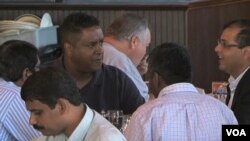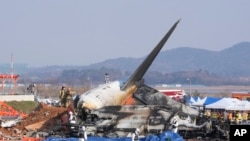ການຄົ້ນຄວ້າໃໝ່ກ່ຽວກັບຊາວອາເມຣິກັນເຊື້ອສາຍເອເຊຍ ຊຶ່ງຊົນກຸ່ມນ້ອຍທີ່ກຳລັງ
ເຕີບໄວທີ່ສຸດຢູ່ໃນສະຫະລັດ ໄດ້ເຜີຍໃຫ້ເຫັນວ່າ ປະຊາຄົມທີ່ແຕກຕ່າງກັນຢ່າງໃຫຍ່
ຫລວງ.
ສູນກາງຄົ້ນຄວ້າ PEW ກ່າວວ່າ ພົນລະເມືອງອາເມຣິກັນເຊື້ອສາຍເອເຊຍ ໄດ້ເຕີບ
ໂຕກາຍ 20 ລ້ານຄົນລະຫວ່າງປີ 2000 ແລະ 2015 ຊຶ່ງເປັນການເພີ້ມ 72 ເປີເຊັນ.
ໃນການປຽບທຽບ ໃສ່ຈຳນວນຂອງພວກທີ່ປາກພາສາສະແປນິສ ຊຶ່ງເປັນກຸ່ມທີ່ເຕີບ
ໂຕໄວອັນດັບສອງຂອງປະເທດ ແມ່ນໄດ້ເພີ້ມຂຶ້ນ 60 ເປີເຊັນໃນໄລຍະ15 ປີທີ່ຜ່ານ
ມານີ້.
ສ່ວນນຶ່ງຂອງພວກຊົນກຸ່ມນ້ອຍທີ່ເປັນກຸ່ມຍ່ອຍລົງມາ ເຕີບໂຕໄວທີ່ສຸດກໍໄດ້ແກ່ຊາວ
ພູຖານ ຊາວເນປານແລະຊາວມຽນມາ ໃນຂະນະທີ່ກຸ່ມເຕີບໂຕຊ້າທີ່ສຸດທີ່ໄດ້ບັນທຶກ
ໄວ້ນັ້ນ ແມ່ນຮວມທັງຊາວລາວ ແລະຍີ່ປຸ່ນ.
ຊາວອາເມຣິກັນເຊື້ອສາຍເອເຊຍມີຮາກເຫງົ້າມາຈາກ 20 ປະເທດໃນເອເຊຍຕາເວັນ
ອອກ ເອເຊຍຕາເວັນອອກສຽງໃຕ້ ແລະ ອິນເດຍ ອີງຕາມສູນກາງ PEW ທີ່ກ່າວວ່າ
94 ເປີເຊັນຂອງຊາວອາເມຣິກັນເຊື້ອສາຍເອເຊຍ ແມ່ນມາຈາກ 19 ກຸ່ມຫຼັກ.
ອົງການ PEW ກ່າວວ່າ ຊາວອາເມຣິກັນເຊື້ອສາຍເອເຊຍຈະເປັນພວກຄົນເຂົ້າເມືອງ
ກຸ່ມໃຫຍ່ທີ່ສຸດໃນສະຫະລັດ ໃນປີ 2055 ເວລາເຂົາເຈົ້າຄາດໝາຍວ່າຈະ ກາຍພວກທີ່
ປາກພາສາສະແປນິສ. ຊາວເອເຊຍ ຈະປະກອບເປັນ 38 ເປີເຊັນ ຂອງພວກຄົນເຂົ້າ
ເມືອງທັງໝົດໃນ 50 ປີ ໃນຂະນະທີ່ພວກທີ່ປາກພາສາສະແປນິສ ຈະປະກອບເປັນ 31
ເປີເຊັນ ອີງຕາມການຄົ້ນຄວ້າທີ່ທຳນາຍໄວ້.
ລາຍງານແຈ້ງວ່າ ຄົນທີ່ມີເຊື້ອສາຍຈີນເປັນກຸ່ມທີ່ໃຫຍ່ສຸດມີຢູ່ 4 ລ້ານ 9 ແສນ ຄົນ ທີ່
ປະກອບເປັນເກືອບນຶ່ງສ່ວນສີ່ ຂອງພົນລະເມືອງຊາວເອເຊຍ. ຊາວອິນເດຍແລະຄົນ
ທີ່ສືບເຊື້ອສາຍມາຈາກຟິລິບປີນແມ່ນກຸ່ມໃຫຍ່ຮອງລົງມາມີພົນລະເມືອງ 4 ລ້ານ ແລະ
3 ລ້ານ 9 ແສນຄົນ ຕາມລຳດັບ. ອົງການ PEW ພົບເຫັນວ່າ ຊາວຫວຽດນາມ ເກົາຫລີ
ແລະຍີ່ປຸ່ນ ແຕ່ລະກຸ່ມມີຫຼາຍກວ່າ 1 ລ້ານຄົນ. ສ່ວນທີ່ຍັງເຫລືອຢູ່ 13 ກຸ່ມ ແມ່ນປະ
ກອບເປັນ 12 ເປີເຊັນຂອງຊາວເອເຊຍຢູ່ໃນສະຫະລັດ.
ອົງການ PEW ກ່າວວ່າ ເກືອບ 60 ເປີເຊັນຂອງພົນລະເມືອງອາເມຣິກັນເຊື້ອ ສາຍເອ
ເຊຍ ແມ່ນເກີດຢູ່ຕ່າງປະເທດ ແຕ່ວ່າໂຕເລກດັ່ງກ່າວ ແຕກຕ່າງໃນແຕ່ລະກຸ່ມ ພຽງແຕ່
27 ເປີເຊັນ ຂອງຊາວຍີ່ປຸ່ນ ເກີດຢູ່ຕ່າງປະເທດ ປຽບທຽບໃສ່ 92 ເປີເຊັນຂອງຊາວ
ພູຖານ.
ໃນກໍລະນີຄົນເຂົ້າເມືອງຜິດກົດໝາຍນັ້ນ ອົງການ PEW ໄດ້ພົບເຫັນວ່າ ຊາວເອເຊຍ
ມີຢູ່ 13 ເປີເຊັນ ຂອງການກະປະມານທັງໝົດ 11 ລ້ານ 1 ແສນຄົນທີ່ເຂົ້າເມືອງຜິດ
ກົດໝາຍ.
ທັງໝົດແລ້ວ ຊາວອາເມຣິກັນເຊື້ອສາຍເອເຊຍມີເສດຖະກິດດີ ປຽບທຽບໃສ່ພົນລະ
ເມືອງອາເມຣິກັນທັງໝົດ ແຕ່ການສຳຫລວດຂອງອົງການ PEW ໃຫ້ຂໍ້ສັງເກດວ່າ
ຄວາມອຸດົມຮັ່ງມີ “ແຕກຕ່າງກັນ ຢ່າງກວ້າງຂວາງ” ລະຫວ່າງບັນດາ ຊົນກຸ່ມນ້ອຍ.
ລາຍໄດ້ຄອບຄົວປານກາງຂອງຊາວເອເຊຍແມ່ນ 73,060 ໂດລາຕໍ່ປີ ເກືອບ 20,000
ໂດລາ ຫລາຍກວ່າອັດຕາສະເລ່ຍ ຂອງສະຫະລັດ 53,000 ໂດລາ. ຄອບຄົວອິນເດຍ
ມີລາຍໄດ້ສູງທີ່ສຸດ 100,000 ຕໍ່ປີ ໃນຂະ ນະທີ່ຊາວມຽນມາມີລາຍໄດ້ຕໍ່າສຸດ 36,000
ໂດລາຕໍ່ປີ.
ມີພຽງ 12.1 ເປີເຊັນຂອງຊາວເອເຊຍຢູ່ໃນຄວາມທຸກຈົນ ປຽບທຽບໃສ່ 15.1 ເປີເຊັນ
ຂອງ
ພົນລະເມືອງອາເມຣິກັນທັງໝົດ. ຊາວອິນເດຍມີອັດຕາຄວາມທຸກຍາກຕໍ່າສຸດ 7.5 ເປີ
ເຊັນ ແລະມຽນມາ ຢູ່ໃນລະດັບສູງສຸດ 35 ເປີເຊັນ.
A new study of Asian-Americans, the fastest-growing racial or ethnic group in the United States, reveals an extremely diverse community.
The Pew Research Center says the population of Asian-Americans grew to just over 20 million between 2000 and 2015 -- an increase of 72 percent. In comparison, the number of Hispanics, who comprise the nation's second-fastest growing group, increased by 60 percent during that 15-year period.
Some of the fastest-growing subgroups were Bhutanese, Nepalese and Burmese, with the slowest growth rates registered among Laotians and Japanese.
Asian-Americans have roots in more than 20 countries in East Asia, Southeast Asia and the Indian subcontinent, according to Pew, which says 94 percent of Asian-Americans are from 19 origin groups.
Pew said Asian-Americans will be the largest immigrant group in the U.S. by 2055 when they are expected to pass Hispanics. Asians will make up 38 percent of all immigrants in 50 years, while Hispanics will make up 31 percent, the study predicts.
People of Chinese origin make up the largest group, which, at 4.9 million, comprise nearly one-quarter of the Asian population. Indians and people of Philippine descent are the next largest, with populations of 4 million and 3.9 million, respectively, the study said. Pew found that Vietnamese, Koreans and Japanese each have over 1 million people. The remaining 13 origin groups account for 12 percent of Asians in the United States.
Pew says nearly 60 percent of the U.S. Asian population are foreign born, but that number varies by group, with only 27 percent of Japanese being foreign born, compared to 92 percent of Bhutanese.
In terms of illegal immigration, Pew found Asians made up 13 percent of the estimated 11.1 million illegal immigrants.
Overall, Asian-Americans fare well economically, compared with the rest of the U.S. population, but the Pew survey notes that prosperity "varies widely" among the subgroups. The median household income for Asians was $73,060 per year, almost $20,000 more than the U.S. average of $53,600. Indian households had the highest income at $100,000 per year, while Burmese had the lowest at $36,000.
Only 12.1 percent of Asians live in poverty compared to 15.1 percent of the overall U.S. population. Indians had the lowest poverty rate, at 7.5 percent, and Burmese had the highest level, at 35 percent.
Regarding education, the survey said 51 percent of Asians ages 25 and older have a bachelor's degree or more. That compared to 30 percent for the entire country. Again, the percentages vary, depending on the subgroup, with 72 percent of Indians having a bachelor's degree or more. Only 9 percent of Bhutanese had a college degree or higher.
About 70 percent of Asian-Americans over the age of 5 were proficient in English, but like other measures, the figure varies widely among subgroups. Eighty-four percent of Japanese-Americans were proficient, while only 27 percent of Bhutanese spoke the language well. Less than one-third of Asian-Americans spoke English at home, Pew said.
Forty-five percent of Asian-Americans live in the Western U.S. with about a third living in California. That figure compares to 23 percent in the South, 20 percent in the Northeast and 12 percent in the Midwest.










